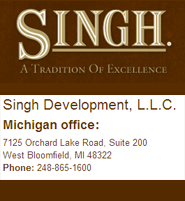|
|
|
|
|
|
Buffalo is the second largest city in New York State. Located in Western New York on the eastern shores of Lake Erie and at the head of the Niagara River, Buffalo is the principal city of the Buffalo-Niagara Falls metropolitan area and the seat of Erie County. The city itself has a population of 292,648 (2000 Census), and the metropolitan area 1,170,111 (2000 Census)[7], the 46th largest in the United States.
Originating around 1789 as a small trading community near the eponymous Buffalo Creek, Buffalo grew quickly after the opening of the Erie Canal in 1825, with the city as its terminus. By 1900, Buffalo was the 8th largest city in the country, and went on to become a major railroad hub, the largest grain-milling center in the country, and the home of the largest steel-making operation in the world. The latter part of the 20th Century saw a reversal of fortunes: by the year 2000 the city had fallen back below its 1900 population levels. The rerouting of Great Lakes shipping by the opening of the St. Lawrence Seaway was a factor in the decline of the city. The closing or relocating of many of the steel mills and other heavy industries in the area also contributed to the decline.
The name "Buffalo" may be derived from the French phrase beau fleuve, "beautiful river", a description of Buffalo Creek and the Niagara River; the matter is uncertain, but it is clear that there were no bison in the area. It likely dates from the mid-18th century, when the area was first settled by Europeans. The area was originally settled by a Neutral Nation tribe, the Ongiara. Later, the Senecas of the Iroquois Confederacy won control over this land from the Neutrals. In 1804, Joseph Ellicott, a principal agent of the Holland Land Company, designed a radial street and grid system that branches out from downtown like bicycle spokes, and is one of only three radial street patterns in the US. During the War of 1812, on December 30, 1813, the village of Buffalo was burned by British forces. On November 4, 1825 the Erie Canal was completed with Buffalo being at the western end of the system. The population at the time was about 2,400. The Erie Canal brought a surge in population and commerce which led Buffalo to incorporate as a city in 1832 with a population of about 10,000 people.
One of Buffalo's many monikers is the City of Trees, which describes the abundance of green in the city. In fact, Buffalo has more than 20 parks with multiple ones being accessible from any part of the city.
The Olmsted Park and Parkway System is the hallmark of Buffalo's many green spaces. Three-fourths of city park land is part of the system, which comprises six major parks, eight connecting parkways, nine circles and seven smaller spaces. Begun in 1868 by Frederick Law Olmsted and his partner Calvert Vaux, the system was integrated into the city and marks the first attempt in America to lay out a coordinated system of public parks and parkways. The Olmsted designed portions of the Buffalo park system are listed on the National Register of Historic Places and are maintained by the Buffalo Olmsted Parks Conservancy.
Situated at the confluence of Lake Erie and the Buffalo and Niagara Rivers, Buffalo is a waterfront city. The city's rise to economic power came through its waterways in the form of transshipment, manufacturing, and an endless source of energy. Buffalo's waterfront is still a hub of commerce, trade, and industry that is essential to its economic prosperity.
Buffalo's waterfront is being transformed from its industrial past into a focal point for social and recreational activity. A literal focal point, viewed from above, is a marina taking the shape of a buffalo (located near the junction of the Buffalo Skyway NY 5 and the New York State Thruway I-190.
The Niagara Frontier Transportation Authority (NFTA) operates Buffalo Niagara International Airport and Niagara Falls International Airport, and the public transit system throughout the Buffalo area. The NFTA operates bus lines throughout the city and suburbs, as well as the Metro Rail transit system in the city.
The Metro Rail is a 6.4 mile (10.3 km) long, single line rail that extends from downtown Buffalo to the University Heights district in north Buffalo. The downtown section of the line is operated above ground and is free of charge to passengers. Outside the downtown area the line transitions to an underground system until it reaches the end of the line at University Heights. Passengers must pay a fee to ride this section of the rail.
Two train stations, Buffalo-Depew and Buffalo-Exchange Street serve the city and are operated by Amtrak. VIA Rail also serves these stations for travel into Canada.
Freight service for Buffalo is served by CSX Transportation and Norfolk Southern (NS), as well as Canadian National (CN) and Canadian Pacific (CP) railroads from across the Border. The area has 4 large rail yards: Frontier (CSX), Bison (NS), SK (NS / CP) and Buffalo Creek (NS / CSX). A large amount of hazardous cargo also crosses through the Buffalo area, such as liquid propane and anhydrous ammonia.
Buffalo is served by the Buffalo Niagara International Airport, located in Cheektowaga. The airport, recently re-constructed, serves over 5 million passengers a year and is still growing. Buffalo Niagara International Airport ranks among the five cheapest airports from which to fly in the country, according to the U.S. Bureau of Transportation Statistics. The average round trip flight cost $295.58. As of 2006, plans are in the works by U.S. Senator Charles Schumer to make the under-used Niagara Falls International Airport into an international cargo hub for New York and Toronto, as well as Canada as a whole.
|
|
|




|
|
|
|
|